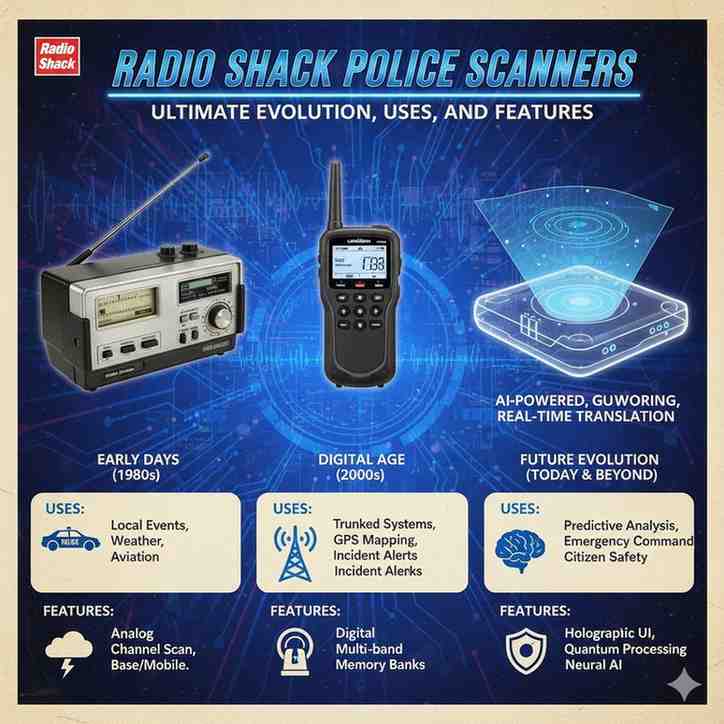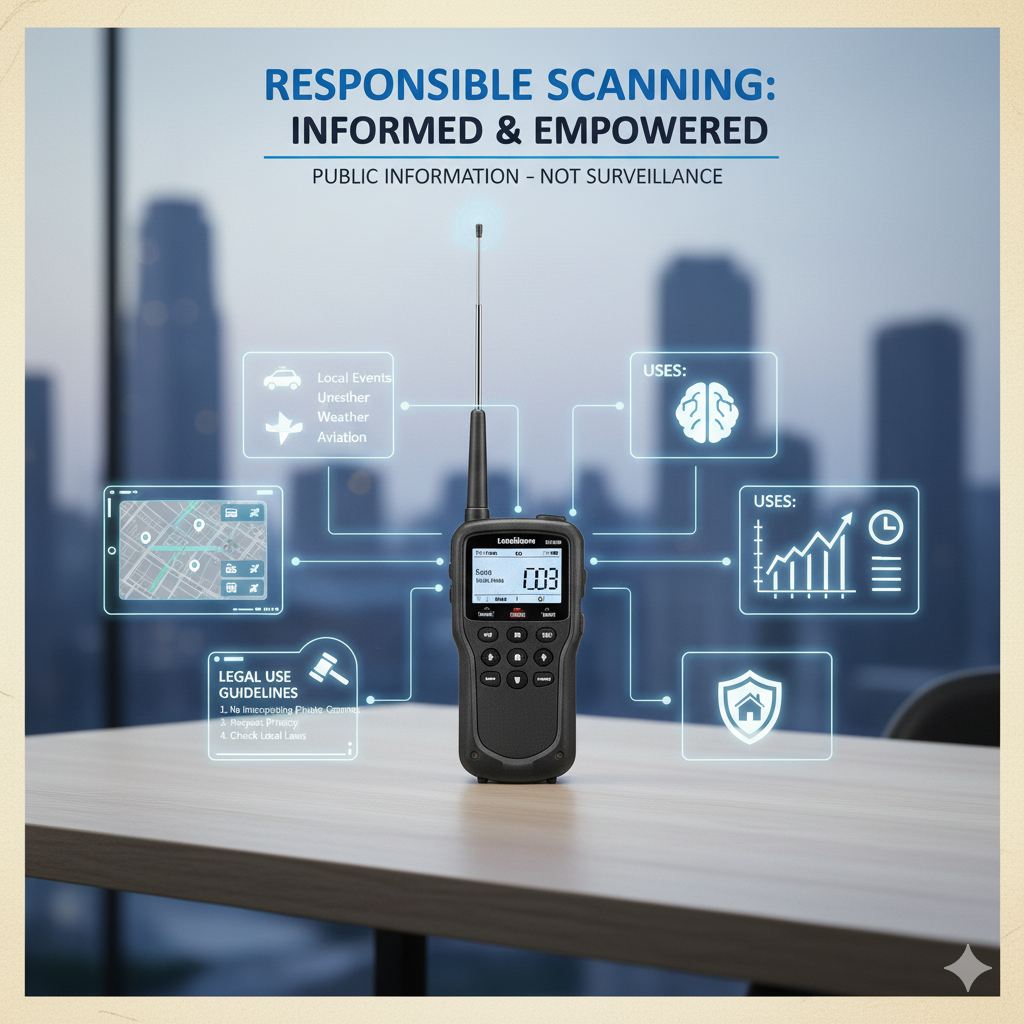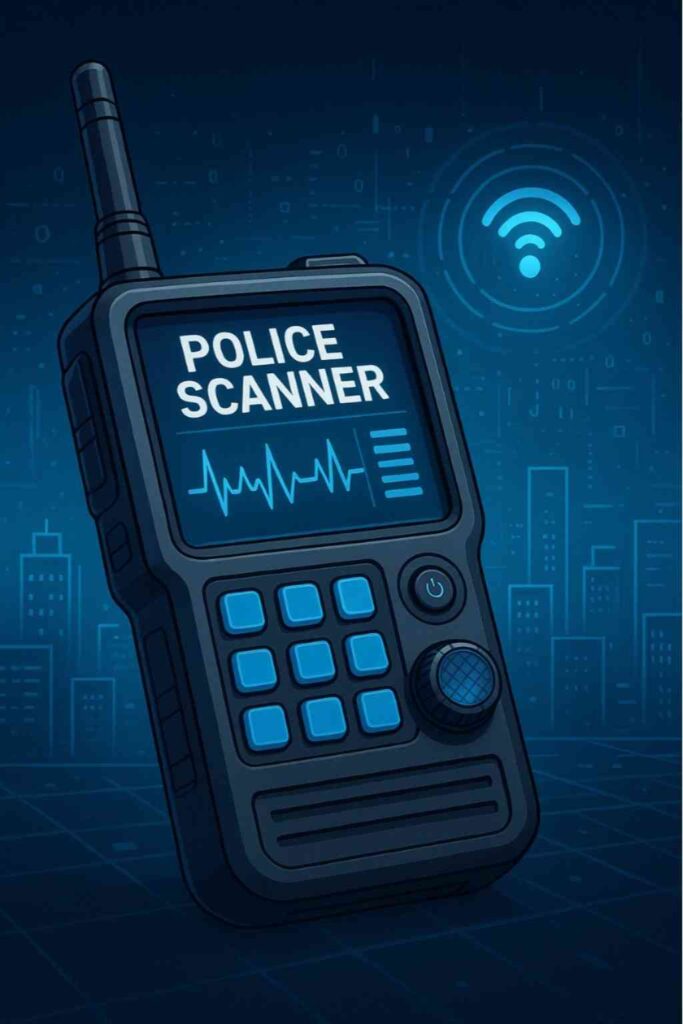Radio Shack Police Scanners: Evolution and Modern Applications
For decades, Radio Shack police scanners have provided users with the ability to monitor public safety communications and other important radio frequencies. These devices have become essential tools for hobbyists, journalists, emergency responders, and concerned citizens looking to stay informed. Over the years, these scanners have evolved from simple, analog devices to highly sophisticated, digital systems capable of intercepting a wide range of radio signals.
In this article, we will explore the history of Radio Shack police scanners, their modern applications, and how they have adapted to today’s digital world. We’ll also discuss how to use them legally and responsibly.
The History of Radio Shack Police Scanners
The story of Radio Shack police scanners began in the mid-20th century, when public interest in monitoring radio frequencies emerged. Early scanners were basic analog devices that allowed users to listen to a limited range of police, fire, and emergency service communications. At that time, intercepting police transmissions was simple, as most agencies used open analog frequencies.
Radio Shack became a major player by offering affordable, user-friendly scanners. Iconic models like the PRO series became popular, and as public interest grew, so did demand. Radio Shack expanded its product line to include advanced models capable of intercepting additional frequencies, such as air traffic control and public utilities.

Here is a unique image representing the transition from analog to digital Radio Shack police scanners, based on the content you provided.
The Transition from Analog to Digital
As communication technology evolved, so did Radio Shack police scanners. In the late 20th century, public safety systems transitioned from analog to digital communications, with many law enforcement agencies, fire departments, and emergency services adopting encrypted digital systems for added security.
This shift created a challenge for analog scanner users, who could no longer intercept digital transmissions. In response, Radio Shack introduced models capable of receiving digital signals, allowing users to keep monitoring emergency communications. Some of these models, such as the PRO-96 and PRO-2096, became popular among hobbyists and professionals alike.
Though digital scanners offered more advanced features, they required greater technical knowledge. Users had to program specific frequencies and codes to effectively monitor digital communications. Despite the learning curve, these digital models expanded the range of accessible communications.
Modern-Day Applications of Radio Shack Police Scanners
Today, Radio Shack police scanners continue to serve a variety of functions in both professional and recreational settings. While the technology has advanced, the core purpose remains the same: to allow users to monitor public safety and emergency communications. Here are some of the key applications of modern-day police scanners:
Emergency Preparedness
Police scanners are invaluable tools for individuals looking to stay informed during emergencies. By monitoring real-time communications from police, fire, and emergency services, users can gain a better understanding of developing situations. Whether it’s a natural disaster, an accident, or a public safety event, police scanners provide crucial information that helps people make informed decisions.
Journalism and Reporting
Many journalists and reporters use police scanners to stay ahead of breaking news. Listening to police and emergency communications allows reporters to be on the scene of incidents quickly. This gives them a competitive edge in covering stories related to crime, accidents, and public safety. Radio Shack police scanners have long been trusted tools for reporters in the field.
Public Safety Monitoring
Public safety agencies and volunteer organizations often use police scanners to coordinate their efforts. Firefighters, EMTs, and search-and-rescue teams can monitor communications from other agencies, ensuring that they are aware of all aspects of a situation. This helps improve coordination and efficiency during emergency response efforts.
Hobbyist Listening
For decades, police scanners have been popular among hobbyists who enjoy listening to radio communications for fun. Some enthusiasts use scanners to monitor air traffic control, marine channels, and even amateur radio operators. Radio Shack police scanners offer a versatile way for hobbyists to explore the radio waves and tune into a variety of communications.
Community Awareness
Some community members use police scanners to stay informed about what’s happening in their local area. By listening to police and fire department communications, they can stay up-to-date on crime, accidents, and other public safety issues. This helps promote community awareness and engagement, as residents are better informed about events affecting their neighborhoods.

Here is the unique image illustrating the advanced features of modern Radio Shack police scanners.
The Features of Modern Radio Shack Police Scanners
Modern Radio Shack police scanners come equipped with a variety of advanced features that enhance their functionality and ease of use. While older models were limited to scanning analog frequencies, today’s scanners are far more versatile and sophisticated. Below are some of the standout features of contemporary police scanners:
Digital Trunking
Many modern police scanners are equipped with digital trunking capabilities, which allow them to follow conversations that occur across multiple frequencies. Trunking systems are commonly used by public safety agencies to improve communication efficiency. A digital trunking scanner can follow these conversations seamlessly, providing users with continuous access to important communications.
Pre-Programmed Frequencies
Some police scanners come with pre-programmed frequencies for specific regions, making it easier for users to start monitoring right out of the box. These pre-programmed scanners save users the hassle of manually inputting frequencies and codes, especially in areas where public safety communications are widely available.
Scan and Search Functions
Modern scanners are equipped with scan and search functions that allow users to explore a wide range of frequencies. The scan function quickly cycles through preset frequencies, stopping when an active transmission is detected. The search function enables users to explore new frequencies that they may not have programmed, providing a broader listening experience.
Analog and Digital Compatibility
Many modern Radio Shack police scanners are capable of receiving both analog and digital transmissions. This ensures that users can monitor a wide range of communications, from older analog systems to newer digital platforms. With this dual compatibility, users can enjoy a more comprehensive scanning experience.
Alpha Tagging
Some advanced police scanners include alpha tagging, a feature that allows users to label specific frequencies with custom names. This makes it easier to identify the source of a transmission without needing to remember specific frequency numbers. For example, a user might label a frequency as “Local Police” or “Fire Dispatch.”
Weather Alerts
Some police scanners also come with built-in weather alert functionality, allowing users to receive emergency weather broadcasts directly from NOAA (National Oceanic and Atmospheric Administration). This feature is particularly useful for individuals who want to stay informed about severe weather conditions in their area.

Here is the unique image illustrating the legal and responsible use of Radio Shack police scanners based on the content provided.
How to Use Radio Shack Police Scanners Legally and Responsibly
While Radio Shack police scanners provide valuable access to public safety communications, it’s important to use them responsibly and in compliance with local laws. The legality of owning and using police scanners varies depending on your location, so it’s crucial to understand the rules in your area before purchasing or using one.
Understand Local Laws
In some areas, it may be illegal to listen to certain frequencies or communications, especially if they are encrypted. Many public safety agencies now encrypt their communications to protect sensitive information. It is important to know which frequencies are legally accessible in your area and avoid attempting to decrypt or listen to encrypted transmissions.
Avoid Using Scanners in Vehicles
Some states and countries have laws prohibiting the use of police scanners in vehicles without a special permit. In many cases, this is to prevent individuals from using scanners to evade law enforcement or track police activity. Always research local laws regarding scanner use in vehicles to avoid legal issues.
Respect Privacy
It’s essential to respect the privacy of individuals and agencies when using a police scanner. Avoid sharing sensitive or private information that you might overhear while listening to public safety communications. Broadcasting or recording these transmissions without permission may violate privacy laws.
Stay Informed on Updates
As technology evolves, so do the laws and regulations surrounding police scanners. Stay informed about any updates to laws or rules regarding scanner use, especially in your local area. This will help you use your scanner responsibly and within the legal framework.
The Future of Police Scanners
The future of Radio Shack police scanners and scanning technology will likely see continued evolution as communication systems become more advanced. With the increasing use of encryption in public safety communications, the accessibility of police scanners may become more limited. However, there will always be a demand for these devices in various sectors.
As digital and software-defined radios (SDRs) become more prevalent, police scanners may incorporate even more sophisticated features, such as software-driven decryption (within legal bounds), enhanced digital decoding, and AI-assisted scanning. Additionally, integration with smartphone apps and other digital platforms could enhance the functionality and usability of police scanners.

Here is the unique image illustrating the future of police scanners, based on your provided content.
FAQ: Radio Shack Police Scanners
1. What is a Radio Shack police scanner?
A Radio Shack police scanner is a device that monitors public safety and emergency communications, allowing users to listen to radio frequencies used by law enforcement, fire departments, and other emergency services.
2. Can Radio Shack police scanners receive digital frequencies?
Yes, many modern Radio Shack scanners are capable of receiving both analog and digital frequencies, including digital trunking systems used by many public safety agencies.
3. Is it legal to use a Radio Shack police scanner?
The legality of using police scanners varies by location. In most cases, it’s legal to own and use one at home, but some states or countries restrict their use in vehicles or prohibit monitoring certain encrypted frequencies.
4. What can I listen to on a police scanner?
You can listen to public safety communications such as police, fire, emergency medical services (EMS), air traffic control, and other public service agencies, depending on local frequencies and laws.
5. How do I program a Radio Shack police scanner?
Programming a scanner involves inputting specific frequencies for your area. Some models come pre-programmed with regional frequencies, while others require manual programming based on local frequency databases.
6. Can I listen to encrypted communications on a Radio Shack scanner?
No, encrypted communications cannot be accessed by standard police scanners. These transmissions are protected for privacy and security reasons, and attempts to decrypt them may violate the law.
7. What are the key features of modern Radio Shack police scanners?
Key features include digital trunking, pre-programmed frequencies, scan and search functions, dual analog and digital compatibility, and the ability to receive weather alerts and tag specific channels with custom names.
8. Can I use a Radio Shack police scanner for emergency preparedness?
Yes, police scanners are valuable tools for emergency preparedness. By listening to real-time public safety communications, you can stay informed during natural disasters, accidents, or other emergencies.
9. Do Radio Shack police scanners require internet or Wi-Fi?
No, traditional police scanners do not require internet or Wi-Fi. They work by receiving radio signals directly from nearby public safety and communication systems.
10. Are Radio Shack police scanners still available?
While Radio Shack no longer operates many physical stores, you can still find Radio Shack police scanners through online retailers, secondhand markets, and alternative brands offering similar products.
Staying Informed with Radio Shack Police Scanners
Radio Shack police scanners have evolved significantly over the years, adapting to changes in communication technology and user needs. From their early days as simple analog devices to the advanced digital models available today, these scanners have played a crucial role in keeping the public informed. Whether you’re using a police scanner for emergency preparedness, journalism, public safety, or hobbyist listening, it’s essential to understand how to use these devices legally and responsibly.
As we move into the future, police scanners will continue to be valuable tools, helping people stay connected to the world around them. By embracing the modern features of Radio Shack police scanners and staying informed about legal and ethical considerations, users can make the most of these powerful devices while contributing to the safety and awareness of their communities.









Leave a Review